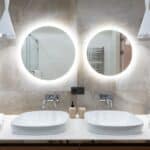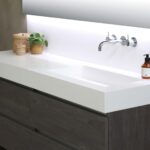This post may contain affiliate links. If you use these links to buy something we may earn a small commission. Thanks.
It’s always beneficial to compare different finishes to faucets when installing them in your home. Whether it’s being installed in your bathroom, your kitchen, or your utility area, it’s important to consider what’s functional and practical for the space.
There’s also personal preference about how you would like it to look from a design perspective. So, which type of faucet is the right choice for your home?
In this brushed nickel vs stainless steel faucet comparison, we’ll help you find the right choice for your bathroom or kitchen.
In this article, you’ll get a better understanding of what each of these finishes provides and what their benefits are.
At the end of the article, you’ll hopefully know what you require so that you can move forward with any project that’s in the pipeline.
What is Brushed Nickel?
Brushed nickel is a finish that is subtle in its appearance. It’s a lot softer and has a slightly brushed appearance that’s complemented with a semi-satin finish. Some people can often get brushed nickel and stainless steel confused because they are fairly similar in how they look.
It’s one of the most popular finishes for bathroom faucets but many homeowners also opt for kitchen faucets too in this finish.
Is brushed nickel good for faucets?
Brushed nickel as an option is extremely durable. Durability is something that is highly important when it comes to faucets because it’s going to get a lot of use over time. The finish of brushed nickel is likely to keep a lot longer than other finishes like chrome for example.
It’s also a finish that’s relatively inexpensive and will go with many of your other fixtures and appliances around the room.
For those who don’t always have the time on hand to clean, brushed nickel doesn’t show fingerprints or water spots, making it a lot easier to maintain. It’s pretty easy to prevent spotting on brushed nickel faucets.
What color is brushed nickel?
Colour is an influential decision-maker when it comes to designing your home. Everything from the type of flooring you pick, the colors of your walls to the minor details of soft furnishings.
Brushed nickel has a natural yellow or somewhat white color. For kitchen and bathroom fixtures, this slight yellow hue is perfect for adding warmth to the room.
There are varieties of brushed nickel fixtures that can come in multiple finishes depending on your requirements. Having a lot of versatility is a major benefit for this type of faucet finish.
Do brushed nickel faucets tarnish?
Like anything you purchase for your home, it’s important that you’re taking good care of it. Otherwise, even the most durable appliances can end up damaged eventually.
With a brushed nickel finish, it can end up developing a milky white tarnish. This develops over time, particularly in bathrooms that generate a lot of humidity. This is simple to avoid though by using a soft cloth and a solution of white vinegar and water – something most people will have in their homes.
Other than that, it’s one of the most popular finishes that’s often used not only for faucets but for cabinet hardware too.
How do you care for brushed nickel faucets?
To get a good investment out of your faucets, it’s important to care for them in the right way. The matte finish of brushed nickel needs to be looked after properly. Where possible, a twice-weekly cleaning schedule that includes polishing will help keep it looking the same as it did from day one.
From toothpaste to soap scum and hard water deposits, it can all contribute to dulling the appearance of your nickel fixtures.
When choosing the right product, it’s best to avoid any bathroom cleaners that are caustic or acid/ammonia-based. That also means bleach, which can ruin the pure nickel for good.
Anything like scratch pads or scrubbing materials that are abrasive should also be avoided as this can strip the brushed finish away. Many homeowners will make the same mistake when cleaning their kitchen appliances like the hob. Again, another example of irreversible damage.
Instead, use a soft cloth or even a toothbrush to clean the metal. This will avoid any corrosion occurring. A professional-grade cleaner and degreaser can be useful in removing dirt and grime from the surface.
You can find a lot more details in our how to clean brushed nickel guide!
Pros: Budget-friendly and extremely durable.
Brushed nickel can serve as a great option for those who are on a budget and don’t want to spend an arm and a leg to get this type of finish. Whilst also being budget-friendly, the finish offers a lot of durability for wherever it’s placed in your home.
Cons: Easily damaged with the wrong cleaning materials.
The downside to this finish is that it can succumb to damage if you end up choosing cleaning products and materials that tarnish or ruin the integrity of the metal.
What is Stainless Steel?
Stainless steel is a finish that is used in a lot of fixtures and fittings. You’ll also find a lot of stainless steel appliances on the market, so it’s one that many will be familiar with, within their homes.
The finish of stainless steel is created using a process called ‘cold rolling‘ the metal through special rolls or dies. As a result, it provides a smoother surface that is then softened and de-scaled within an acid solution.
It has a shiny surface that has an overall pleasing look, especially when pristine. It’s the perfect finish for those who are looking for a seamless look throughout their space, particularly where the metal has been used for other fixtures like cabinet handles.
Is stainless steel good for faucets?
When focusing on design styles, whether that’s in your bathroom or kitchen, it’s useful to be consistent with the metal used. Stainless steel is good for faucets in particular because they provide a mirrored effect that can be good for reflecting light and brightening the space.
Stainless steel is often more durable than most finishes and can last for years if cleaned properly. However, just like brushed nickel you want to avoid using abrasive scrubbers that will damage it.
What metals are in stainless steel?
Unbeknownst to some, stainless steel is actually made up of a number of materials. It’s a corrosion-resistant alloy of iron, chromium and in some cases, nickel. There is some stainless steel that will also incorporate other metals.
It’s always good to check what metals have been used within the stainless steel fixture because that might influence how you maintain and clean the faucet.
What cleans stainless steel faucets?
Just like brushed nickel, stainless steel can be cleaned with products that many homeowners will have around their homes. Baking soda makes a great cleaner for stainless steel faucets. It’s abrasive enough to scrub away any stuck-on food or grease but not so abrasive that it dulls the shine or general appearance of the metal.
Combine baking soda and water until you get a paste and then apply with a plastic scrubber or something non-abrasive. Avoid cleaning materials like wire brushes or steel wool as this will cause immediate damage.
Pros: High durability means you’ll replace it less often.
With a stainless steel finish, it’s tough and serves as an ideal investment for your home. That means you’ll replace it less often and save yourself more money in the long term. Who doesn’t like saving money?
Cons: Easily scratched if careless with cleaning materials.
Again, like brushed nickel, stainless steel is easily flawed if scratched. This can happen fairly easily with the wrong cleaning materials so be careful.
Brushed Nickel vs Stainless Steel Faucet Finish: How do you make a Decision?
In the battle between brushed nickel vs stainless steel, there are some considerations to make before deciding on which one is best for you.
Consider the cost
The cost is often very important when choosing between the two. Stainless steel is often the more affordable option with brushed nickel often being the most expensive.
Stainless steel and brushed nickel are two of the more pricer options when comparing them to other metals like chrome and brass for instance.
Think about what you can afford and what won’t break the bank or cause you to overspend on your planned budget.
Ease of cleaning
Not everyone is a fan of cleaning, with some opting for easy-to-clean alternatives where possible. When it comes to stainless steel and brushed nickel, both are fairly the same in terms of the cleaning required. It’s easy enough for both because they can be cleaned with household ingredients rather than spending money on chemical-heavy products.
These metals are a lot easier to maintain and clean than having to polish brass or tackle an oil-rubbed bronze faucet.
Your room design
As mentioned already, the type of metal you go for is one that should fit with the rest of the room’s aesthetic. There are many design elements that can influence the overall look of the space and these include your kitchen or bathroom faucets.
Make sure that whatever you use matches with the rest of the fixtures and fittings.
Can You Mix Brushed Nickel and Stainless Steel?
When it comes to mixing brushed nickel and stainless steel, it’s not something that can be done. Due to their different finishes, trying to combine them together will result in an unpleasant Frankenstein finish.
If you’re going to mix stainless steel with another finish, use polished nickel as this is also shiny. If you want to mix brushed nickel with another metal, use brass or gold to enhance its natural yellow hue.
Mixing metal finishes together can create some beautiful results but these two finishes don’t mix well.
FAQs
Is brushed nickel going out of style?
Some would consider brushed nickel to be less trendy than it was before. However, to say it’s going out of style is not so true. Even though it might not be the current trend, it’s still a hardware finish that looks good no matter where you use it. It’s still widely available on the market for anyone that’s interested in using it.
Will stainless steel rust if scratched?
Stainless steel contains chromium and this is a key metal that makes it rust-resistant. Even if you were to scratch your stainless steel appliance or faucet, a new chromium oxide layer will form and protect the remaining stainless steel beneath it. So in short, your stainless steel shouldn’t rust if scratched.
How can you clean stainless steel?
When cleaning stainless steel, anything that’s non-abrasive is going to be the best for avoiding scratches or causing unwanted damage. Baking soda and water mixed into a paste can be an ideal solution. However, there are lots of cleaning products out there that have been made for stainless steel in mind.
Is stainless steel good for a kitchen faucet?
Yes, stainless steel is a valid choice to use as a kitchen faucet. It can be highly effective due to its shiny appearance to reflect light and therefore work with even the darkest colors like matte black for example. It’s a tough metal which means even the toughest stains like grease and grime can be easily removed without causing damage.
Final Thoughts
Brushed nickel and stainless steel are fairly similar not just in their appearance but in their durability. The decision really comes down to your budget, what type of style your home has, and ensuring it matches the rest of the space accordingly. It’s safe to say that both these faucet finishes are an ideal investment.
Hopefully this brushed nickel vs stainless steel faucet comparison guide helped you make the best choice for you!
More Faucet Finish Comparisons You May Like…


